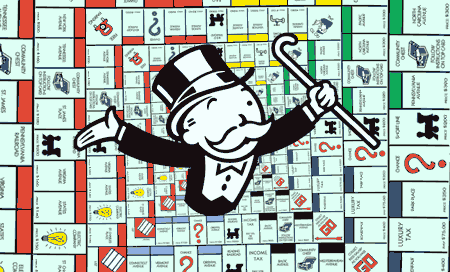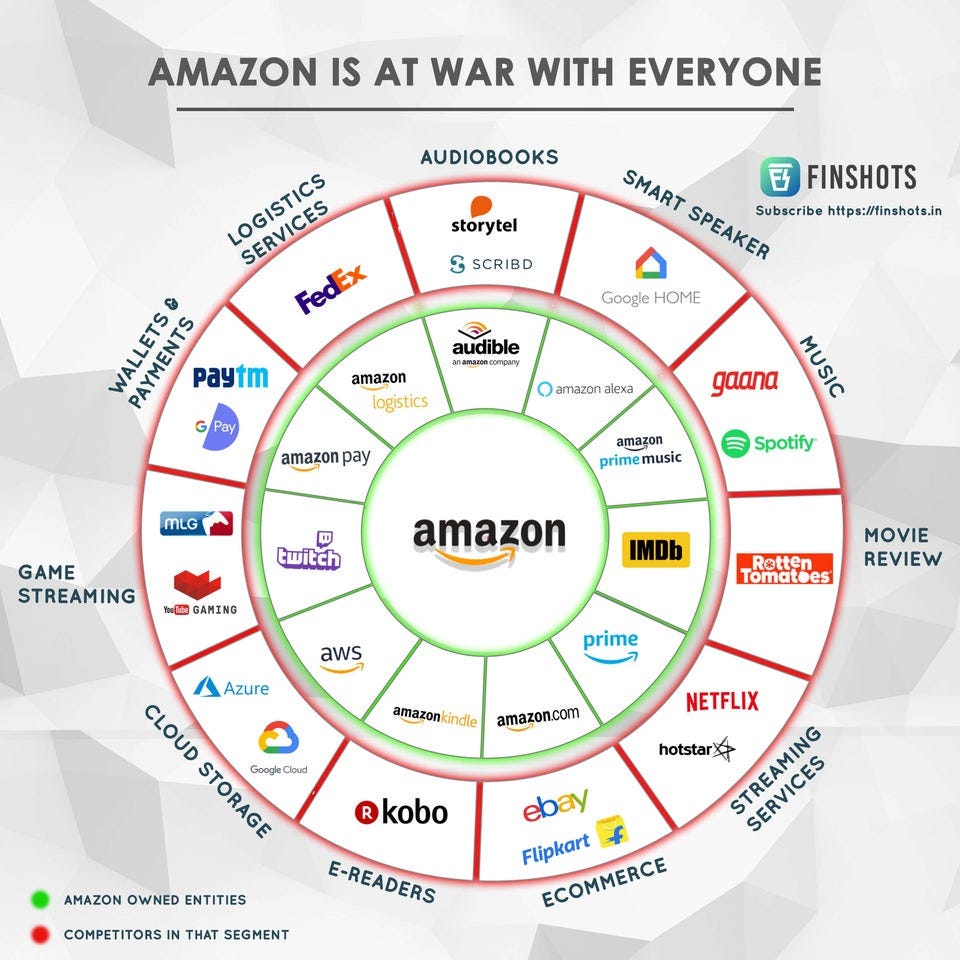Last week Amazon announced a new service called Amazon Pharmacy, which will allow the purchase and distribution of prescription and generic medications. The announcement marked their first foray into the healthcare sector, adding to the laundry list of industries the grasping, greedy hands of Amazon are already gripping.
In my puerile and naive mind I queried, “What the deuce is Amazon if it’s not considered a monopoly?” And so began a deep dive into antitrust laws, duopolies, oligopolies, and the belly of the Bezos behemoth.
United States Antitrust Laws
As defined by the United States Department of Justice, antitrust laws prohibit business practices that “unreasonably deprive consumers of the benefits of competition”, which lead to higher prices for goods and services.
The “benefits of competition” essentially reference competition itself. Without competition, a monopolizing entity can decide the price of a good or service without restraint, since no competing entity can offer similar goods and services at a lower price or in a more attractive offering.
In English, antitrust laws exist to prevent the creation of monopolies. Monopolies are bad for us layfolk because they make goods and services cost more, and subsequently reduce our standards of living.
Historic Examples
The most notable US monopolies were held by Andrew Carnegie’s Steel Company, John D. Rockefeller’s Standard Oil Company, and the American Tobacco Company.
American monopolies date back to the Colonial administrations practice of awarding large companies exclusive contracts to build the New World. From the late 19th century to early 20th, the three companies mentioned above held exclusive rights to the supply of their respective industries.
Without free-market competition, these companies could effectively keep high prices for steel, oil, and tobacco.
Break it Down
The trouble with Amazon stems from the fact that its hands are in so many pots. For those who need a refresher, here are some of the many arms of Amazon:
E-Commerce: The Amazon.com we all know and love.
AWS: Amazon Web Services - cloud storage behemoth that generates a substantial portion of their revenue.
Amazon Logistics: Apart from their logistical dominance in two-day shipping across most of the US, Amazon recently dropped a cool $40b on building out their in-house transportation services. Since 2015, they’ve taken major steps to reduce reliance on third-party logistics partners. (Their current fleet of transportation assets is insane - read more here.)
Whole Foods: Amazon bought the upscale grocery chain in 2017 for ~$13b.
Subscription Services: Amazon Prime gives access to specialized offers, free two-day shipping, Prime Video, Prime Music, and Prime Reading.
Amazon Pharmacy
Twitch: Premier game streaming service.
Zappos: The largest online retailer of shoes when it was bought by Amazon in 2009.
IMDb: Movie review, rating, and discussion forum.
Unlike the historic monopolies mentioned above, Amazon is not cornering a single industry. The many-armed beast that is Amazon bears resemblance to a ravenous octopus, razor-sharp suckers grabbing each industry in a stranglehold.
The Sum of Its Parts
If the whole of Amazon is not a monopoly, what about its individual pieces?
Amazon’s first major disruption struck the book industry. Today, Amazon controls 75% of online book sales, 65% of e-book sales, more than 40% of new book sales, and about 85% of self-published book sales.
Economist Paul Krugman wrote in the New York Times that Amazon has as large a share in the entire book business as Standard Oil did in 1911, before it was broken up into 34 companies.
Predatory Practices
Various reports also cite squeeze tactics used by Amazon to reduce the price of books it purchases from publishers. In 2014, Amazon and Hachette Publishing engaged in open commercial warfare because Amazon wanted a larger cut of profits.
By any definition of antitrust laws, Amazon’s actions towards Hachette are suspect.
This October, the House Judiciary Committee antitrust subcommittee (help, that’s a title) released a 451 page report on competition in digital markets. The report details the ways Apple, Amazon, Google, and Facebook capitalize and allegedly abuse their market power to their own benefit.
Through the report, Amazon is mentioned a whopping 1,866 times, second only to Google at 1,964.
The report has 83 pages dedicated to the analysis of Amazon’s many revenue streams and practices. This analysis is informed by internal company emails, extensive market research, interviews with third-party retailers, submissions from industry groups, and personal testimony.
The essence of the antitrust case against Amazon is stated succinctly:
“Amazon’s pattern of exploiting sellers, enabled by its market dominance, raises serious competition concerns.”
Per the report, there’s no shortage of supporting details. The list of allegations against Amazon include the following, among others:
The use of third-party seller data to inform the creation of its own, Amazon-branded products.
The leveraging of information gleaned from investments in startups as competitive intelligence.
Compelling merchants to use Amazon’s fulfillment services through preferential placement in product listings.
Monopsony vs. Monopoly
The above allegations don’t fit the defining actions of a monopoly. In fact, Amazon has direct, stout competition within every industry it operates in. If a monopoly is the lack of competition and the singular seller of a product or service, Amazon isn’t that.
The graphic below shows Amazon’s competitive market space.
Instead, Amazon is showing signs of a burgeoning monopsony.
A monopsony is the opposite of a monopoly. In overly simplistic terms:
Monopoly: 1 seller, many buyers.
Monopsony: 1 buyer, many sellers.
Apart from Amazon-branded original products, such as Amazon Basics, Alexa, or Kindle, Amazon is a hosting platform for third-party vendors, such as Hachette Publishing.
Since Amazon has such expansive market visibility and use, small vendors stand to benefit from leveraging Amazon’s platform to sell their goods and services.
This is where things get dicey. Since Amazon is in heavy competition in every industry, it moves to offer similar products and services at lower prices. Reducing prices reduces Amazon’s profit, so to offset this loss and make this a viable business venture, Amazon has two main options:
Demand higher commissions from third-party vendors.
We saw this with Hachette Publishing. If the vendor resists, Amazon will likely make their product or service difficult to acquire.
Demand lower prices for products and services of third-party vendors.
This is tell-tale monopsonistic power. Amazon acts as the central buyer, and calls the shots for its associate sellers.
The House Judiciary Committee’s scathing review is with regard to monopsonistic tendencies rather than monopolistic. Of course, this references one portion of Amazon’s business, the third-party sellers.
For a good visual breakdown of Amazon’s other segments, click here.
So - Monopsony, Monopoly, or What?
By these definitions, Amazon is currently neither a monopoly or monopsony.
There are aspects of its business that trend towards monopolistic and monopsonistic characterizations, but the company as a whole is neither; just a gargantuan cash cow that has the ability to bring nearly any product or service to the e-commerce space.
The coming months and years will likely see more antitrust proceedings and litigation leveled at Amazon, as they continue their slow encroachment of American business.
Granted, none of this exonerates Amazon from being complicit in a duopoly or triopoly.
I doubt Adam Smith would find Facebook, Google, Apple, or Amazon to be particularly friendly to free-market capitalism, but that’s a discussion for another time.
As always, thanks for reading.
If you found this to be even slightly titillating to your brain and know someone who’d be interested, please share!









